Electricity - Class 10th Science
NCERT Intext solution
Question: 1. What does an electric circuit mean?
Answer: The close path of electric current is called electric circuit.
Question: 2. Define the unit of current.
Answer: SI unit of electric current is ampere (A).
Electric current is the rate of flow of electric charge through a conductor.
Therefore, electric current = charge/time
The SI unit of Charge is Coulomb.
The SI unit of Time is second
Therefore, unit of electric current = C/s = Cs–1
Thus, ampere which is unit of electric current, is the flow of electric charges through a conductor at the rate of one coulomb per second.
Question: 3. Calculate the number of electrons constituting one coulomb of charge.
Answer:
Charge over 1 electron = 1.6 x 10–19coulomb
Or, 1.6 x 10–19coulomb or charge = 1 electron
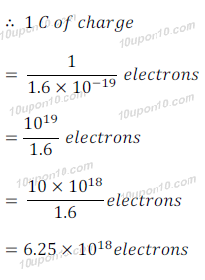
Question: 4. Name a device that helps to maintain a potential difference across a conductor.
Answer: Battery or a cell
Explanation: Battery or a cell is the device that helps to maintain a potential difference across a conductor.
Question: 5. What is meant by saying that the potential difference between two points is 1 V?
Answer: When 1 joule of work is done to move a charge of 1 coulomb between two points, this becomes equal to 1V.
Thus meaning of this saying is; 1V is 1 joule of work is done to move a charge of 1 coulomb between two points.
Question: 6. How much energy is given to each coulomb of charge passing through a 6 V battery?
Answer:
Given,
Charge Q = 1C,
Potential difference, V = 6V
Thus, Energy i.e. Work done, W =?
We know that,
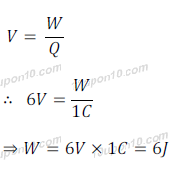
Thus, 6J of energy is given to each coulomb of charge passing through a 6V battery.
Question: 7. On what factors does the resistance of a conductor depend?
Answer: Resistance of a conductor depends upon:
(a) Nature of conductor
(b) Length of conductor
(c) Area of cross section of conductor
Question: 8. Will current flow more easily through a thick wire or a thin wire of the same material, when connected to the same source? Why?
Answer:
Current flows more easily through a thick wire than a thin wire of the same material.
This happens because resistance is indirectly proportional to the area of cross section of the conductor.
This means that resistance decreases with increase in area of cross section and vice versa. This means that a thick wire will produce less resistance than a thin wire of the same material.
Thus, in the case of thick wire, less resistance will be produced which makes current flow easy.
Question: 9. Let the resistance of an electrical component remain constant while the potential difference across the two ends of the component decreases to half of its former value. What change will occur in the current through it?
Answer:
We know that, Resistance (R) 

Let the potential difference becomes half, i.e. V/2

Thus, if potential difference between two ends of the component will be halved, and resistance remains constant, then electric current would also be halved.
Question: 10. Why are coils of electric toasters and electric irons made of an alloy rather than a pure metal?
Answer:
The coil of heating elements must have higher melting point, so that it can retain more heat and would not melt in case of a significant rise in temperature.
Since, alloys have higher melting point than that of pure metals. So, coils of electric toasters and electric irons are made of an alloy rather than a pure metal.
Question: 11. Use the data in Table 12.2 to answer the following :
(a) Which among iron and mercury is a better conductor?
Answer:
Materials with lower resistivity is better conductor.
According to the table 12.2 given in book,
resistivity of iron is 10.0 x 10 –8 Ω m
And the resistivity of mercury is 94.0 x 10 –8 Ω m
Since, resistivity of iron is lower than mercury, therefore, iron is better conductor than mercury.
(b) Which material is the best conductor?
Answer:
Material which has lowest resistivity is considered as best conductor.
According to table 12.2 given in book, the resistivity of silver is 1.60 x 10 –8 Ω m which is the lowest.
Thus, silver is the best conductor.
Question: 12. Draw a schematic diagram of a circuit consisting of a battery of three cells of 2 V each, a 5 Ω resistor, an 8 Ω resistor, and a 12 Ω resistor, and a plug key, all connected in series.
Answer:
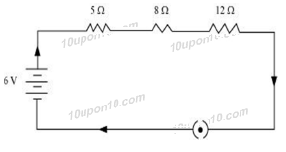
Question: 13. Redraw the circuit of Question 1, putting in an ammeter to measure the current through the resistors and a voltmeter to measure the potential difference across the 12 Ω resistor. What would be the readings in the ammeter and the voltmeter?
Answer:
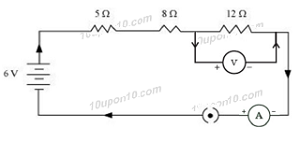
Total resistance in the circuit = Sum of the resistances of all resistors
Therefore total effective resistance, R = 5 Ω + 8 Ω + 12 Ω = 25 Ω
We know;
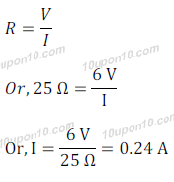
Potential difference through resistance of 12Ω.
Since, electric current does not divide in series circuit,
Thus, electric current, I = 0.24A
Resitance, R = 12Ω

Thus, reading of ammeter = 0.24A and reading of voltmeter = 2.88V